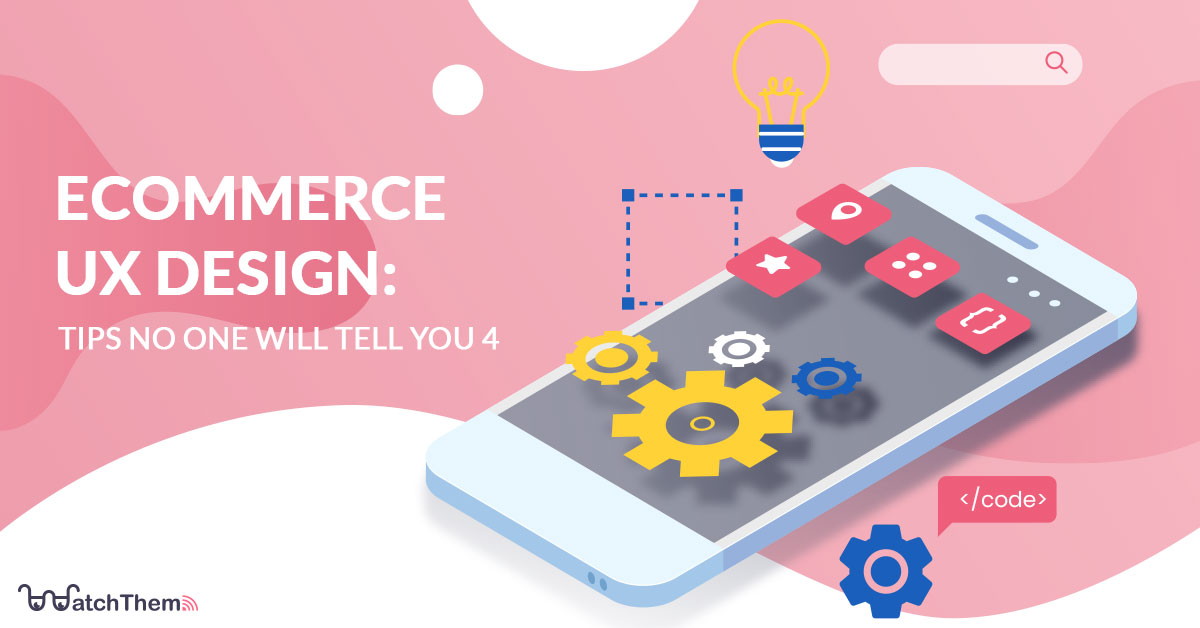Page Contents
If you own an eCommerce website or are thinking of starting one, you should know the importance of giving your users an efficient and enjoyable experience. Of course, customers visit your online store because they need a product you have, but it doesn’t mean you’re their only choice. You need to give them a reason to choose you over your competitors, and if you fail to highlight your unique selling proposition (USP) and provide them with a reason to stay in the first few seconds of their visit, there is a very high chance that you will lose them. This is where eCommerce UX design comes into play. In this article, we discuss the importance of UX design for eCommerce and review four essential tips to improve it. So if you want to know more, keep on reading!
Looking for a tool to improve your eCommerce UX design? Sign up to WatchThemLive for free and find out your customers’ needs to give them the experience they deserve.
Why Is eCommerce UX Design Important?
Keep in mind that you’re not the only website offering services. Users are flooded with so many options that they can and probably will drop off after a few seconds if they’re not satisfied with the experience. To avoid losing your potential customers and maximize your conversion rate, you need to prioritize your users’ experience and do whatever is necessary to keep their attention and even convince them to come back in the future. Here are a number of reasons why you should take eCommerce UX design seriously:
1. Recognize and Fulfill Your Users’ Needs
In the process of UX design, you need to recognize who your users are, deeply investigate their needs, and then do whatever is necessary to meet or even exceed their expectations. Having a positive and convenient experience with your eCommerce makes the user loyal to your brand, so they will revisit your website in the future or even advocate for you and bring in more people.
One of the best ways to find out about your users’ needs is using a behavior analytics tool such as WatchThemLive. This tool offers helpful features including heatmaps, session replays, and user tracking that enable you to understand your users more deeply.
You can create heatmaps for your pages to figure out what attracts users’ interests. Watching session replays, you can see what problems they face when they navigate through your website. And with user tracking, you can follow the whole journey of any specific user throughout your website and see what makes them leave or convert.
These are only a few examples of how you can use WatchThemLive to improve the user experience and there’s a lot more you can do.
Want to try out WatchThemLive to deliver an exceptional user experience? Sign up now and get started!
2. Get More Conversions
There are several reasons for which we emphasize improving our eCommerce UX design, and probably the most important one is that it leads to more conversions. It can be keeping their attention and making them spend more time on our website or having them complete a transaction and buy something from our online store. Whatever our goal is, good UX design can help us achieve it more efficiently.
3. Increase the Speed of Your Website
When a user opens your website, you don’t have more than a few seconds to persuade them that you’re the best possible answer to their current need and convince them to stay on your page, and if you fail, there is a high chance that they will bounce. To realize how important of a factor time is, let’s take a look at some statistics:
Based on research done by Google researchers in 2017, as page load time goes from:
- One second to 3 seconds: the probability of users leaving your page increases by 32%.
- If it takes up to 5 seconds: the possibility of bounce increases by 90%,
- And if it takes 10 seconds for your page to load, bounce probability is likely to increase even up to 123%!
How Do You Optimize UX Design for an eCommerce Store?
Now that you’re aware of the importance of UX for e-commerce, let’s review some significant tips that will help your customers have a better experience using your website and increase the conversion rate to a great extent.
1. Make Navigation As Easy As Possible
One of the most common mistakes made by online retailers is having a website that is difficult to navigate. Nothing may turn a buyer off faster than attempting to discover a product on a website with jumbled navigation. Even worse is not splitting the categories or differentiating the items according to their types. Or, much worse is when there are categories with no items or just one or two. In this case, the term “category” loses its meaning.
Before adding products to the catalog, make sure you have clear categories and navigation features. Ensure that each category contains a few products and merge the smaller categories.
Recommended Reading: eCommerce Navigation: 7 Best Practices You Must Know


2. Avoid Lengthy Checkouts
Among all mistakes one can commit, this is the worst one. According to eCommerce studies, the average cart abandonment rate is about 70 percent, which means among ten potential buyers, about seven of them will not complete the transaction. One of the most important steps to minimize the cart abandonment rate is simplifying the checkout process. To make it easier for your users to convert:
- Don’t force them to sign up and offer guest checkout.
- Provide several payment methods.
- Have a minimum number of form fields.
- Have a checkout page that looks and feels coherent and consistent.
- Don’t send them to other websites to pay.
- Reassure them that their information will remain safe and secure.


3. Allow Users to Share Their Reviews and Feedbacks
It’s important to provide enough information about the product you sell. Even in a physical store where customers can see and touch the products they need and have the right to know more about what they’re buying. This factor is even more critical in an online store where customers decide for their purchase only based on pictures and descriptions. So, the more the information, the better.
But do you know what customers trust more than what you tell them about your product? What other customers say about it! Let people share their reviews, experience, and questions about your products. Even encourage them to do so. This way, they know there is a way they can reach out to you. They feel more in touch with your brand and are assured that you will support them and care about their problems even after the purchase is made.
Users’ feedbacks are also essential in improving eCommerce UX design because UX at its core is about finding out what users need and who can tell us about what our users need, more than the users themselves?


4. Provide Good Customer Service
Good customer service is probably one of the most valuable things you can provide for your users. Customer service is critical to generating more revenue. It is also essential for building customer loyalty, defined as a customer’s willingness to do business with you again in the future. One positive customer service encounter might alter a consumer’s entire impression of your website. Overall, customer service is vital because it:
- gives value to you and your users,
- makes your customers trust you,
- is even more important than the price in some cases,
- creates brand recognition,
- reduces the customer attrition rate,
- increases CLV and ROI.


Conclusion
Creating a good user experience is vital for any online store. A great user experience attracts and retains users, increases conversions, and encourages them to become loyal customers. Designing a great user experience is one of the most important things to consider when you first start creating your website.
In order to achieve a good e-commerce design, in addition to the fundamental aspects, you need to pay attention to new trends and opportunities to keep it up to date.
Need a tool to find out how to improve your eCommerce UX design? Sign up to WatchThemLive to get actionable insights.


